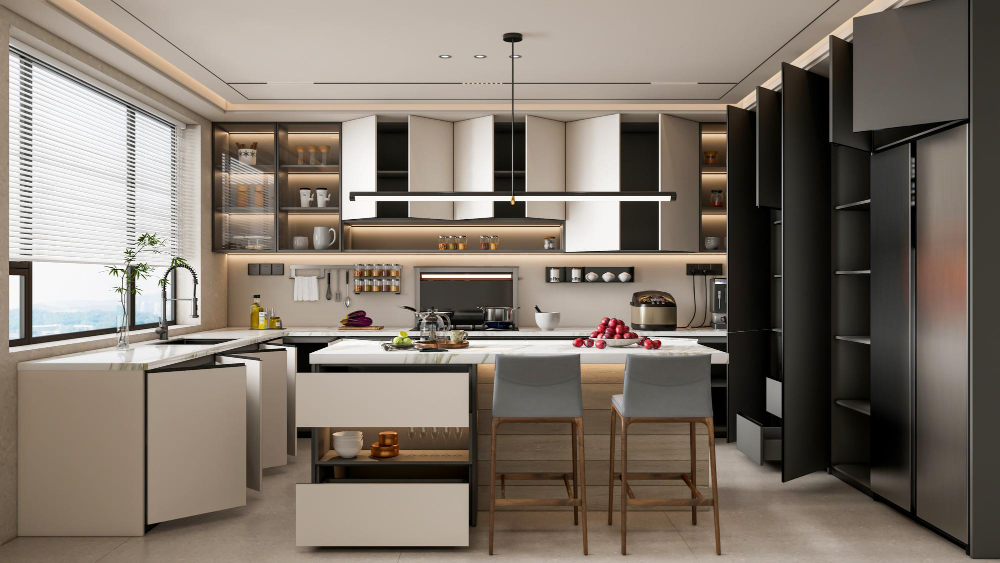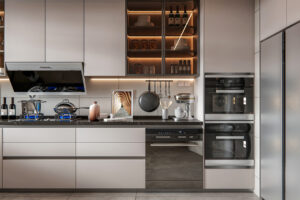Modern kitchens are trending toward calm, simplicity, and subtle sophistication. The best designs balance openness and precision — where every line, tone, and texture serves a purpose. Choosing the right cabinet door style is at the heart of that approach.
This contemporary kitchen cabinet door design guide explores how minimalist principles can transform your cabinetry into a statement of quiet confidence.
The Essence of Minimalist Cabinet Design
Minimalism doesn’t mean empty. It means intentional. In cabinetry, this translates to:
- Streamlined forms: Flat panels, concealed hinges, and clean hardware lines.
- Monochrome palettes: Subdued tones like warm white, sand, or graphite.
- Balanced symmetry: Doors and drawers aligned for rhythm and flow.
Every element contributes to visual peace — creating kitchens that feel uncluttered and timeless.
1. Choose Seamless Cabinet Profiles
Minimalist design begins with continuity. Frameless, slab-style doors give kitchens a sleek edge and expand the feeling of space.
Why it works:
- Reduces visual distraction.
- Highlights architectural form over ornamentation.
- Works in both compact and open layouts.
Pair with recessed handles or touch-latch systems for a truly seamless appearance.


2. Keep the Palette Simple but Warm
All-white kitchens are evolving into layered neutrals — think soft ivory, mushroom gray, or clay beige. These tones maintain minimalism while adding warmth and dimension.
Pro Tip: Use contrasting countertops in light quartz or textured stone for subtle variation without breaking the flow.
3. Focus on Texture Instead of Color
When working with a restrained palette, surface texture becomes the hero.
Minimalist Finishes for 2025:
- Matte lacquer for a velvety, non-reflective surface.
- Textured laminate to mimic linen or brushed concrete.
- Rift-cut oak veneer for an organic, natural touch.
Even minimal kitchens need tactile appeal — texture adds depth without visual noise.
4. Use Hidden or Integrated Hardware
Visible hardware can interrupt a minimalist aesthetic. Replace knobs and pulls with hidden channels, edge grooves, or push-open mechanisms.
Benefits:
- Cleaner visual lines.
- Easier cleaning and maintenance.
- Enhanced sense of flow across cabinetry.
This small detail transforms ordinary cabinetry into refined architectural millwork.
5. Eliminate Visual Clutter
Minimalism thrives on openness.
- Keep countertops clear — store appliances behind lift-up or pocket doors.
- Use matching toe-kicks to extend cabinetry visually to the floor.
- Align cabinet joints with ceiling or window heights for structural cohesion.
Design Tip: Lighting matters — soft, warm LEDs accentuate form without harsh contrast.
6. Material Pairings for a Modern Minimalist Kitchen
| Cabinet Finish | Countertop Pairing | Mood Created |
|---|---|---|
| Matte white lacquer | Light gray quartz | Airy and bright |
| Pale oak veneer | Concrete-look quartz | Natural and grounded |
| Charcoal laminate | Warm wood butcher block | Urban sophistication |
The key is balance — subtle contrasts, continuous flow, and timeless restraint.
Builder’s Notes
Minimalist kitchens prove that restraint can be luxurious. Clean lines, harmonious proportions, and quiet textures create spaces that feel effortless yet intentional.
👉 When planning your remodel, think subtraction, not addition. The less visual noise, the more your craftsmanship and materials will shine.




